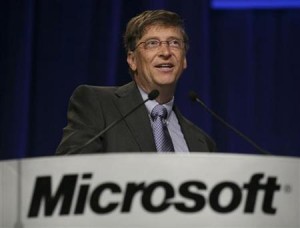Tags
Apple Computer, astrology, Bill Gates, Bill Joy, Computer, Eric Schmidt, Google, Information Technology, Microsoft, Steve Jobs, Sun Microsystems, Tim Berners-Lee
 Besides a genius for working with computers and making boatloads of money many of the most influential people in the world of computing and information technology share another important connection.
Besides a genius for working with computers and making boatloads of money many of the most influential people in the world of computing and information technology share another important connection.
In his latest book, Outliers, author Malcolm Gladwell reports that Bill Gates, the late Steve Jobs, Bill Joy, Eric Schmidt and Sir Tim Berners-Lee all were born during a critical 11-month period between November 1954 and October 1955.
Gates, of course, is founder and inventor of Microsoft and the Windows operating system. Jobs was Apple Computer’s founder and developer of the Mac, iPod, iPhone and Pixar.
Joy is the co-founder of Sun Microsystems and, as the company’s chief scientist, was involved in development of the UNIX and JAVA systems. Schmidt was Sun Microsystems’ first software manager and is now the genius guiding daily operations as CEO of Google.
All London-born Sir Tim Berners-Lee did was invent the World Wide Web while at CERN, the European Particle Physics Lab in Geneva.
According to Gladwell, the list of information-age overachievers who entered the world during this critical time period doesn’t end with this elite group. It also includes software innovators David Winer, who pioneered webblogs, RSS and podcasts; James Gosling, the inventor of Java software; Tim Bray, a former Director at Sun Microsystems now with the Android team at Google; and Ray Ozie, a software architect for Microsoft and the creator of Lotus notes.
Gladwell speculates that those born during this critical 11-month period benefited from a leap in technology at a key stage in their education. The rapid technological advances in the early 1970s ended the computer punch-card era and created “unprecedented access to computer mainframes and real-time computing while these individuals were still in their teens.”
At least two members of the group, Gates and Joy, had an opportunity to acquire more than 10,000 hours of computer programming experience before beginning their careers, he said.
British astrologer Robert Currey, also born in 1955, taught himself to write astronomical and astrological software. Birth charts (horoscopes) produced using his popular Equinox program are marketed on the Internet and worldwide through a network of retail shops that includes The Astrology Shop in Covent Garden, London, and licensee shops in Dublin, Paris, Johannesburg, New York, Sydney and Portland, Ore.
Currey acknowledges the importance of fortuitous timing but says the technology “leap” that made computer punch-cards obsolete in the early 1970s was phased in over a number of years and doesn‘t explain the spike in the graph that occurred in 1955.
“On this basis, the distribution of computer geniuses by birth date should have increased exponentially throughout the 1950s and into the l960s,” he said.
The astrologer believes a more compelling explanation involves a rare generational line-up of the planets Uranus and Neptune with Chiron, a comet-like body that is orbiting the sun between Saturn and Uranus. The configuration formed what astrologers call a T-square, and in every case was strongly aligned with personal planets in birth charts of the information age innovators.
The aspect started to consolidate in the heavens around 1952 and separated in mid-1958. However, throughout 1955, it was at its closest with a peak middle stage on June 11, just three days before World Wide Web inventor Berners-Lee was born.
Currey says Uranus is the planet most closely linked by astrologers to computers, information technology and intellectual breakthroughs. Neptune is connected with the process of merging the imagination and a world beyond existing boundaries.
Chiron was only discovered in 1977 but astrologers now associate it with the process of synthesis and integration. Its involvement in the stressful T-square aspect would have left the creative computer geniuses “with a feeling of dissatisfaction with the technology of the day and an awareness of the short-comings of their creations.
“They would feel painfully and self-critically conscious that it could be so much better no matter how much the world may praise them for their achievements,” he said.
In addition to the computer wunderkinds, Currey said many inventive mathematicians, astrophysicists and chess masters were born under the challenging astrological aspect as well.
“The type of genius that manifests in any period of history is a reflection of the complex interaction between human, cultural and scientific evolution and the unfolding cycles of the universe. By connecting with the potential in their birth chart these individuals can embody and lead the zeitgeist — the spirit of the times,” he said.
